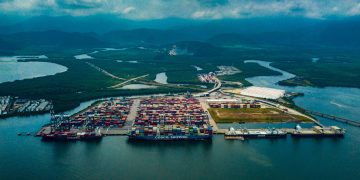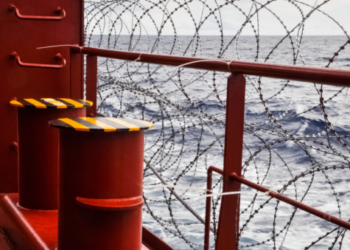Following the Directorate General of Shipping (DGS) mandate requiring the installation of Closed-Circuit Television (CCTV) systems on Indian-flagged vessels, a notice has been issued to operators with recommendations on the proper placement of these cameras on board.
As explained, this measure is part of the DGS strategy to enhance maritime safety & security onboard. This is being mandated for Indian Flag Merchant vessels and foreign vessels trading in Indian Coasts under Specific Period License (SPL). However, this measure is also recommended for foreign flag vessels visiting Indian Ports.
In this context, vessel owners/ ISM managers, in coordination with the Master shall conduct a comprehensive assessment to identify and create a design plan for CCTV system basis vessel- specific vulnerabilities and optimal camera placement, including an assessment of potential areas crucial to safety and security, including the need to be instrinsically safe for tankers in hazardous zones.
Regarding the placement of the cameras onbard, DGS recommends the following:
- Port and Starboard Main deck: 1 on each side/ Recommended functions: zoom and Ingress Protection (IP) rating of IP66 or IP67 or IP68
- Forecastle, Mooring and stern areas: 1 in each area/ Recommended functions: zoom and Ingress Protection (IP) rating of IP66 or IP67 or IP68
- Navigation Bridge: 1 in each areas/ Recommended functions: Technology to analyse incidents (optional)
- Citadel: 1 inside and 1 outside the area / Recommended functions: CCTV Monitoring station
- Accommodation Exterior/ Lifeboat decks: 1 in each area (depending on size of vessel) / Recommended functions: zoom and Ingress Protection (IP) rating of IP66 or IP67 or IP68
The CCTV system shall be part of the vessels IT infrastructure and cyber risk management procedures.
Installation of the CCTV’s should be done in a professional manner, preferably by qualified shore technicians where the cables and installations does not jeopardize the fire integrity of the vessel (including being intrinsically safe where required) or disturb any critical processes or cause distractions when keeping a navigational watch or safe cargo watches.
The equipment should be capable of being isolated in those areas where such recording is not allowed as per local regulations or military sensitivities. Signages should be prominently displayed in common areas to clearly inform crew members and visitors about the presence of CCTV surveillance to avoid any potential legal concerns of privacy and data security. These signs serve to communicate the purpose of the cameras which is to maintain a secure and controlled environment.
The use of Artificial Intelligence (AI) or system-based software to enhance the functionality of CCTV systems is highly recommended as it can significantly improve onboard safety and security. These technologies can enable real-time monitoring, advanced anomaly detection, and automated alerts, ensuring quicker responses to potential incidents while reducing the reliance on manual surveillance.
Recommended specifications and operation of CCTV systems
The Recommended Specifications of the CCTV Cameras and associated equipment are as specified:
a) A minimum resolution of 1080p Full HD, a frame rate of at least 30 fps and a wide dynamic range (WDR) capability.
b) Where long range detection is identified during the pre-survey, the cameras should have zoom facilities, like in areas of open decks or stern areas.
c) On Open decks, the camera should be of IP rating of IP66 or IP67 or IP68 quality.
d) To be preferably of a recognized marine standard and preferably type approved to ensure performance and vibration, humidity, temperature, corrosion resistance, internet protocol (IP) and Electromagnetic Compatibility (EMC) requirements are met.
e) In machinery spaces, the cameras should be able to withstand higher temperatures and preferably have thermal detection. f) Comply with RO Standards or IEC 62676 for Video Surveillance Systems.
Recommended control and monitoring of CCTV systems
The Recommended Control and Monitoring stations and the Transmission Capability of the CCTV Systems are as follows
a) There should be at least one monitoring and control station on the Bridge or Engine room or Cargo Control Room and in the Citadel/Safe Muster Point onboard.
b) The monitoring station should be able to control the view of the cameras and switch between cameras easily.
c) The data from the CCTV should be capable of having a storage capacity of a minimum of 14 days.
d) The monitoring of CCTV footage (online and offline) of the Indian Flag Merchant Vessels is restricted to the Directorate General of Shipping, Vessel, its ISM Managers or DPA or Owners thereof. It should not be entrusted to external agencies or coastal states/port authorities, except if authorized by this Directorate.
e) The Vessel, its ISM Managers or DPA or Owners thereof may use this data for internal purposes related to training and operations assessments to ensure compliance with safety and security protocols.
Recommended training and maintenance of CCTV systems
The Recommended Training and Maintenance procedures for the CCTV Systems are as follows:
a) The Master or safety officer and security officer onboard should be familiar with the monitoring and transmission of the CCTV systems on the vessels.
b) Crew onboard should be trained to use the system when they join onboard and during Man overboard drills, SAR Drills and security drills.
c) The DPA / ISM Manager should be trained to use the system when transmitted ashore and practised during the Ship-Shore drills.
The CCTVs should be periodically inspected by the ship staff weekly and serviced annually onboard or by an authorised service centre. Records to be available for review during audits and inspections.
The notice informs that any malfunctions in the equipment, including cameras, will not be considered a deficiency during flag state inspections or port state control inspections.
For Indian-flagged vessels calling at foreign ports, non-compliance with the Notice will not result in the issuance of a deficiency by the port state control authority. This is issued with the approval of the competent authority.


































































